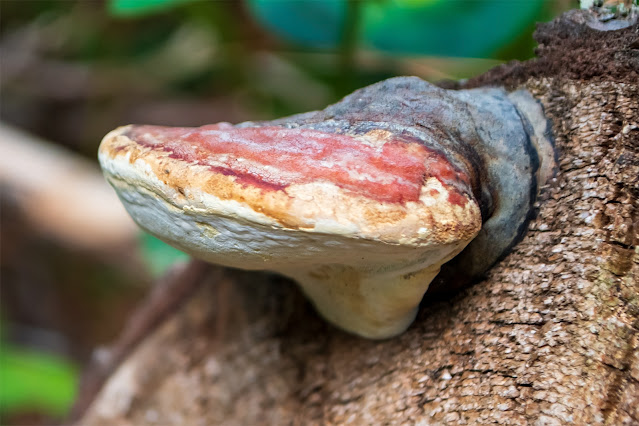Following a narrow trail through the woods beside the shore of Echo Lake, I found a smallish tree that had been felled, de-limbed, and cut into sections, as if it was prepared to be hauled out for firewood. And then forgotten. And every section of the log bore a good number of red-belted polypores.
 |
| Red-belted polypore, Fomitosis mounceae, aka F. pinicola |
The conks that we see are the fruiting body of the fungus; the threads of the mycelium that make up the mass of the fungus grow invisibly in the heartwood of the living tree. Once the tree dies, it moves into the sapwood as well, breaking down the wood, returning it to the soil.
 |
| A smaller conk, growing on the side of the fallen trunk. |
When the tree is standing, the pore layer faces downward along the length of the trunk. Conks that sprout on a tree lying on the ground face crosswise, usually growing on the cut ends or the downward slope of the log. The pores always open vertically. So looking at a fallen tree, you can tell if the conks are old or new.
 |
| On the end of a broken branch. |
It looks like this one started out on the broken end of the branch while the tree still stood, then turned to grow towards the new downside. These fungi respond to their surroundings: they're aware.
~~~~~~~~~~~~~~~~
Al lado de un senderito entre el bosque que bordea el lago Echo, encontré un arbolito que había sido talado, desnudado de sus ramas, cortado en secciones como preparándolo para el transporte, y luego abandonado. Y cada sección llevaba un buen número de hongos políporos.
Foto: Fomitopsis mounceae, también conocido como F. pinicola.
Los conchos que vemos son el cuerpo fructífero del hongo; los hilos (hifas) del micelio que forman la masa del hongo crecen escondidos en la madera del corazón del árbol vivo. Una vez muerto el árbol, el micelio invade la albura también, descomponiendo la madera, regresando los nutrientes a la tierra.
Políporo. La palabra describe el cuerpo fructífero; tiene muchos poros. Poros muy pequeños, unos 3 o 4 por milímetro. Se orientan hacia la tierra desde la capa inferior del concho; aquí se forman las esporas, y desde aquí caen y se las lleva el aire. La parte superior del concho es dura, muchas veces marcada o rota, frecuentemente cubierta de musgos. La cara inferior se ve limpia y fresca, ya que cada año se forma una capa nueva de poros.
Foto: otro políporo.
Cuando el árbol vive y se mantiene de pie, la capa de poros se dirige a lo largo del tronco, hacia el suelo. Los conchos que salen en un árbol caído se orientan perpendicularmente al tronco, brotando desde los extremos cortados o los lados más bajos del tronco caído. Los poros siempre se abren hacia abajo. Así que, mirando un tronco, puedes saber si los cuerpos fructíferos brotaron antes o después de que cayó el árbol.
Pero pueden también cambiar de orientación, según sea necesario.
Foto: un políporo en el extremo de una ramita rota. Parece que brotó desde la parte rota cuando el árbol vivía, y luego cambió de dirección para mirar hacia abajo de nuevo. Estos hongos están conscientes de lo que pasa en su mundo.

No comments:
Post a Comment
I'm having to moderate all comments because Blogger seems to have a problem notifying me. Sorry about that. I will review them several times daily, though, until this issue is fixed.
Also, I have word verification on, because I found out that not only do I get spam without it, but it gets passed on to anyone commenting in that thread. Not cool!